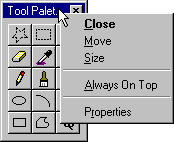
For more information about toolbars and palette windows, see Chapter 7, "Menus, Controls, and Toolbars."
Palette windows are modeless secondary windows that present a set of controls. For example, when toolbar controls appear as a window, they appear in a palette window. Palette windows are distinguished by their visual appearance. The height of the title bar for a palette window is shorter, but it still includes only a Close button in the title area, as shown in 8.15.
Note 
For more information about toolbars and palette windows, see Chapter 7, "Menus, Controls, and Toolbars."

Figure 8.15 A palette window
Make the title text for a palette window the name of the command that displays the window or the name of the toolbar it represents. The system supplies default size and font settings for the title bar and title bar text for palette windows.
Note 
The title bar height and font size settings can be accessed using the SystemParameters-Info function. For more information about this function, see the documentation included in the Microsoft Win32 Software Development Kit (SDK).
You can define palette windows as a fixed size, or, more typically, sizable by the user. Two visual cues indicate when the window is sizable: changing the pointer image to the size pointer, and placing a Size command in the window's pop-up menu. Preserve the window's size and position so the window can be restored if it, or its associated primary window, is closed.
Like other windows, the title bar and the border areas provide an access point for the window's pop-up menu. Commands on a palette window's pop-up menu can include Close, Move, Size (if sizable), Always On Top, and Properties, as shown in Figure 8.16.

Figure 8.16 A pop-up menu for a palette window
Including the Always On Top command or property in the window's property sheet allows the user to configure the palette window to always stay at the top of the Z order of the window set of which it is a part. Turning off this option keeps the palette window within its set of related windows, but allows the user to have other windows of the set appear on top of the palette window. This feature allows the user to configure preferred access to the palette window.
You can also include a Properties command on the palette window's pop-up menu to provide an interface for allowing the user to edit properties of the window, such as the Always On Top property, or a means of customizing the content of the palette window.